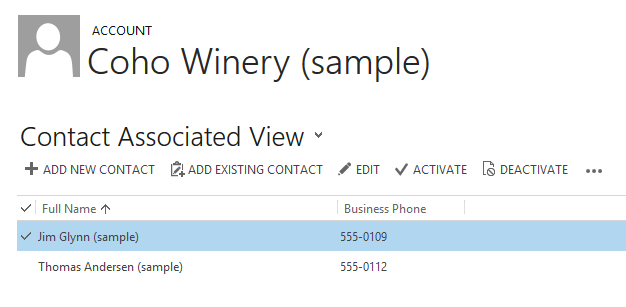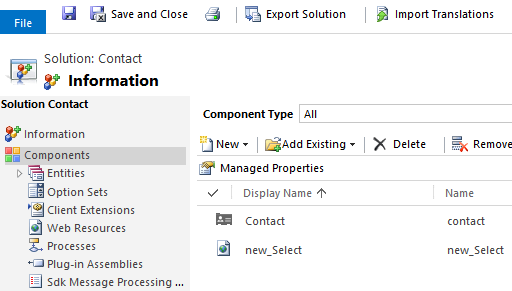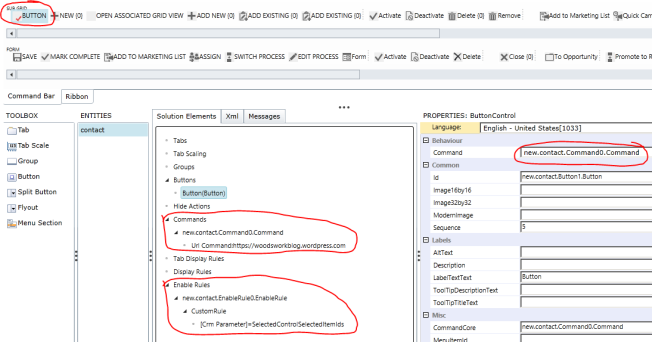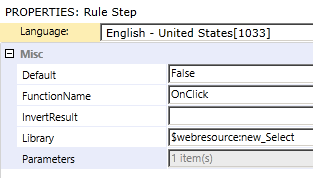1. Get the GUID value of a lookup field:
Note: this example reads and pops the GUID of the primary contact on the Account form
1
2
3
4
|
function AlertGUID() {
var primaryContactGUID = Xrm.Page.data.entity.attributes.get("primarycontactid").getValue()[0].id;
alert(primaryContactGUID);
}
|
2. Get the Text value of a lookup field:
Note: this example reads and pops the name of the primary contact on the Account form
1
2
3
4
|
function AlertText() {
var primaryContactName = Xrm.Page.data.entity.attributes.get("primarycontactid").getValue()[0].name;
alert(primaryContactName);
}
|
3. Get the value of a text field:
Note: this example reads and pops the value of the Main Phone (telephone1) field on the Account form
1
2
3
4
|
function AlertTextField() {
var MainPhone = Xrm.Page.data.entity.attributes.get("telephone1").getValue();
alert(MainPhone);
}
|
4. Get the database value of an Option Set field:
Note: this example reads and pops the value of the Address Type (address1_addresstypecode) field on the Account form
1
2
3
4
5
6
|
function AlertOptionSetDatabaseValue() {
var AddressTypeDBValue = Xrm.Page.data.entity.attributes.get("address1_addresstypecode").getValue();
if (AddressTypeDBValue != null) {
alert(AddressTypeDBValue);
}
}
|
5. Get the text value of an Option Set field:
Note: this example reads and pops the value of the Address Type (address1_addresstypecode) field on the Account form
1
2
3
4
5
6
|
function AlertOptionSetDisplayValue() {
var AddressTypeDisplayValue = Xrm.Page.data.entity.attributes.get("address1_addresstypecode").getText();
if (AddressTypeDisplayValue != null) {
alert(AddressTypeDisplayValue);
}
}
|
6. Get the database value of a Bit field:
1
2
3
4
|
function GetBitValue(fieldname) {
return Xrm.Page.data.entity.attributes.get(fieldname).getValue();
}
|
7. Get the value of a Date field:
returns a value like: Wed Nov 30 17:04:06 UTC+0800 2011
and reflects the users time zone set under personal options
1
2
3
4
|
function GetDate(fieldname) {
return Xrm.Page.data.entity.attributes.get(fieldname).getValue();
}
|
8. Get the day, month and year parts from a Date field:
1
2
3
4
5
6
7
8
9
10
11
12
13
14
15
16
|
function FormatDate(fieldname) {
var d = Xrm.Page.data.entity.attributes.get(fieldname).getValue();
if (d != null) {
var curr_date = d.getDate();
var curr_month = d.getMonth();
curr_month++;
var curr_year = d.getFullYear();
return curr_date + "-" + curr_month + "-" + curr_year;
}
else return null;
}
alert(FormatDate("new_date2"));
|
9. Set the value of a string field:
Note: this example sets the Account Name field on the Account Form to “ABC”
1
2
3
4
|
function SetStringField() {
var Name = Xrm.Page.data.entity.attributes.get("name");
Name.setValue("ABC");
}
|
10. Set the value of an Option Set (pick list) field:
Note: this example sets the Address Type field on the Account Form to “Bill To”, which corresponds to a database value of “1”
1
2
3
4
|
function SetOptionSetField() {
var AddressType = Xrm.Page.data.entity.attributes.get("address1_addresstypecode");
AddressType.setValue(1);
}
|
11. Set a Date field / Default a Date field to Today:
1
2
|
Xrm.Page.data.entity.attributes.get("new_date1").setValue(new Date());
|
12. Set a Date field to 7 days from now:
1
2
3
4
5
6
|
function SetDateField() {
var today = new Date();
var futureDate = new Date(today.setDate(today.getDate() + 7));
Xrm.Page.data.entity.attributes.get("new_date2").setValue(futureDate);
Xrm.Page.data.entity.attributes.get("new_date2").setSubmitMode("always");
}
|
13. Set the Time portion of a Date Field:
1
2
3
4
5
6
7
8
9
10
11
|
function SetTime(attributeName, hour, minute) {
var attribute = Xrm.Page.getAttribute(attributeName);
if (attribute.getValue() == null) {
attribute.setValue(new Date());
}
attribute.setValue(attribute.getValue().setHours(hour, minute, 0));
}
SetTime('new_date2', 8, 30);
|
14. Set the value of a Lookup field:
Note: here I am providing a reusable function…
1
2
3
4
5
6
7
8
9
10
11
|
function SetLookupValue(fieldName, id, name, entityType) {
if (fieldName != null) {
var lookupValue = new Array();
lookupValue[0] = new Object();
lookupValue[0].id = id;
lookupValue[0].name = name;
lookupValue[0].entityType = entityType;
Xrm.Page.getAttribute(fieldName).setValue(lookupValue);
}
}
|
Here’s an example of how to call the function (I retrieve the
details of one lookup field and then call the above function to populate
another lookup field):
1
2
3
4
5
6
|
var ExistingCase = Xrm.Page.data.entity.attributes.get("new_existingcase");
if (ExistingCase.getValue() != null) {
var ExistingCaseGUID = ExistingCase.getValue()[0].id;
var ExistingCaseName = ExistingCase.getValue()[0].name;
SetLookupValue("regardingobjectid", ExistingCaseGUID, ExistingCaseName, "incident");
}
|
15. Split a Full Name into First Name and Last Name fields:
1
2
3
4
5
6
7
8
|
function PopulateNameFields() {
var ContactName = Xrm.Page.data.entity.attributes.get("customerid").getValue()[0].name;
var mySplitResult = ContactName.split(" ");
var fName = mySplitResult[0];
var lName = mySplitResult[1];
Xrm.Page.data.entity.attributes.get("firstname").setValue(fName);
Xrm.Page.data.entity.attributes.get("lastname").setValue(lName);
}
|
16. Set the Requirement Level of a Field:
Note: this example sets the requirement level of the Address Type field on the Account form to Required.
Note: setRequiredLevel(“none”) would make the field optional again.
1
2
3
4
|
function SetRequirementLevel() {
var AddressType = Xrm.Page.data.entity.attributes.get("address1_addresstypecode");
AddressType.setRequiredLevel("required");
}
|
17. Disable a field:
1
2
3
4
|
function SetEnabledState() {
var AddressType = Xrm.Page.ui.controls.get("address1_addresstypecode");
AddressType.setDisabled(true);
}
|
18. Force Submit the Save of a Disabled Field:
1
2
|
Xrm.Page.data.entity.attributes.get("new_date1").setSubmitMode("always");
|
19. Show/Hide a field:
1
2
3
4
|
function hideName() {
var name = Xrm.Page.ui.controls.get("name");
name.setVisible(false);
}
|
20. Show/Hide a field based on a Bit field
1
2
3
4
5
6
7
8
9
|
function DisableExistingCustomerLookup() {
var ExistingCustomerBit = Xrm.Page.data.entity.attributes.get("new_existingcustomer").getValue();
if (ExistingCustomerBit == false) {
Xrm.Page.ui.controls.get("customerid").setVisible(false);
}
else {
Xrm.Page.ui.controls.get("customerid").setVisible(true);
}
}
|
21. Show/Hide a nav item:
Note: you need to refer to the nav id of the link, use F12 developer tools in IE to determine this
1
2
3
4
|
function hideContacts() {
var objNavItem = Xrm.Page.ui.navigation.items.get("navContacts");
objNavItem.setVisible(false);
}
|
22. Show/Hide a Section:
Note: Here I provide a function you can use. Below the function is a sample.
1
2
3
4
5
6
7
8
|
function HideShowSection(tabName, sectionName, visible) {
try {
Xrm.Page.ui.tabs.get(tabName).sections.get(sectionName).setVisible(visible);
}
catch (err) { }
}
HideShowSection("general", "address", false);
|
23. Show/Hide a Tab:
Note: Here I provide a function you can use. Below the function is a sample.
1
2
3
4
5
6
7
8
|
function HideShowTab(tabName, visible) {
try {
Xrm.Page.ui.tabs.get(tabName).setVisible(visible);
}
catch (err) { }
}
HideShowTab("general", false);
|
24. Save the form:
1
2
3
|
function SaveAndClose() {
Xrm.Page.data.entity.save();
}
|
25. Save and close the form:
1
2
3
|
function SaveAndClose() {
Xrm.Page.data.entity.save("saveandclose");
}
|
26. Close the form:
Note: the user will be prompted for confirmation if unsaved changes exist
1
2
3
|
function Close() {
Xrm.Page.ui.close();
}
|
27. Determine which fields on the form are dirty:
1
2
3
4
5
6
7
8
9
|
var attributes = Xrm.Page.data.entity.attributes.get()
for (var i in attributes)
{
var attribute = attributes[i];
if (attribute.getIsDirty())
{
alert("attribute dirty: " + attribute.getName());
}
}
|
28. Determine the Form Type:
Note: Form type codes: Create (1), Update (2), Read Only (3), Disabled (4), Bulk Edit (6)
1
2
3
4
5
6
|
function AlertFormType() {
var FormType = Xrm.Page.ui.getFormType();
if (FormType != null) {
alert(FormType);
}
}
|
29. Get the GUID of the current record:
1
2
3
4
5
6
|
function AlertGUID() {
var GUIDvalue = Xrm.Page.data.entity.getId();
if (GUIDvalue != null) {
alert(GUIDvalue);
}
}
|
30. Get the GUID of the current user:
1
2
3
4
5
6
|
function AlertGUIDofCurrentUser() {
var UserGUID = Xrm.Page.context.getUserId();
if (UserGUID != null) {
alert(UserGUID);
}
}
|
31. Get the Security Roles of the current user:
(returns an array of GUIDs, note: my example reveals the first value in the array only)
1
2
3
|
function AlertRoles() {
alert(Xrm.Page.context.getUserRoles());
}
|
32. Determine the CRM server URL:
1
2
3
4
5
6
7
|
var serverUrl = Xrm.Page.context.getServerUrl();
if (serverUrl.match(/\/$/)) {
serverUrl = serverUrl.substring(0, serverUrl.length - 1);
}
|
33. Refresh a Sub-Grid:
1
2
|
var targetgird = Xrm.Page.ui.controls.get("target_grid");
targetgird.refresh();
|
34. Change the default entity in the lookup window of a Customer or Regarding field:
Note: I am setting the customerid field’s lookup window to offer
Contacts (entityid 2) by default (rather than Accounts). I have also
hardcoded the GUID of the default view I wish displayed in the lookup
window.
1
2
3
4
5
|
function ChangeLookup() {
document.getElementById("customerid").setAttribute("defaulttype", "2");
var ViewGUID= "A2D479C5-53E3-4C69-ADDD-802327E67A0D";
Xrm.Page.getControl("customerid").setDefaultView(ViewGUID);
}
|
35. Pop an existing CRM record (new approach):
1
2
3
4
5
6
7
8
|
function PopContact() {
var primaryContactGUID = Xrm.Page.data.entity.attributes.get("primarycontactid").getValue()[0].id;
if (primaryContactGUID != null) {
Xrm.Utility.openEntityForm("contact", primaryContactGUID)
}
}
|
36. Pop an existing CRM record (old approach):
Note: this example pops an existing Case record. The GUID of the
record has already been established and is stored in the variable
IncidentId.
01
02
03
04
05
06
07
08
09
10
11
12
|
var features = "location=no,menubar=no,status=no,toolbar=no";
var serverUrl = Xrm.Page.context.getServerUrl();
if (serverUrl.match(/\/$/)) {
serverUrl = serverUrl.substring(0, serverUrl.length - 1);
}
window.open(serverUrl + "/main.aspx?etn=incident&pagetype=entityrecord&id=" + encodeURIComponent(IncidentId), "_blank", features, false);
|
37. Pop a blank CRM form (new approach):
1
2
3
|
function PopNewCase() {
Xrm.Utility.openEntityForm("incident")
}
|
38. Pop a new CRM record with default values (new approach):
1
2
3
4
5
6
7
8
9
10
11
12
13
14
|
function CreateIncident() {
var AccountGUID = Xrm.Page.data.entity.getId();
var AccountName = Xrm.Page.data.entity.attributes.get("name").getValue();
var parameters = {};
parameters["title"] = "New customer support request";
parameters["casetypecode"] = "3";
parameters["customerid"] = AccountGUID;
parameters["customeridname"] = AccountName;
parameters["customeridtype"] = "account";
Xrm.Utility.openEntityForm("incident", null, parameters);
}
|
39. Pop a new CRM record with default values (old approach):
Note: this example pops the Case form from the Phone Call form,
defaulting the Case’s CustomerID based on the Phone Call’s SenderID and
defaulting the Case Title to “New Case”
1
2
3
4
5
6
7
8
9
10
11
12
13
14
15
16
17
18
19
20
21
22
23
|
var CallerGUID = Xrm.Page.data.entity.attributes.get("from").getValue()[0].id;
var CallerName = Xrm.Page.data.entity.attributes.get("from").getValue()[0].name;
var extraqs = "&title=New Case";
extraqs += "&customerid=" + CallerGUID;
extraqs += "&customeridname=" + CallerName;
extraqs += "&customeridtype=contact";
var features = "location=no,menubar=no,status=no,toolbar=no";
var serverUrl = Xrm.Page.context.getServerUrl();
if (serverUrl.match(/\/$/)) {
serverUrl = serverUrl.substring(0, serverUrl.length - 1);
}
window.open(serverUrl + "/main.aspx?etn=incident&pagetype=entityrecord&extraqs=" + encodeURIComponent(extraqs), "_blank", features, false);
|
40. Pop a Dialog from a ribbon button
Note: this example has the Dialog
GUID and CRM Server URL hardcoded, which you should avoid. A simple
function is included which centres the Dialog when launched.
01
02
03
04
05
06
07
08
09
10
11
12
13
|
function LaunchDialog(sLeadID) {
var DialogGUID = "128CEEDC-2763-4FA9-AB89-35BBB7D5517D";
serverUrl = serverUrl + "cs/dialog/rundialog.aspx?DialogId=" + "{" + DialogGUID + "}" + "&EntityName=lead&ObjectId=" + sLeadID;
PopupCenter(serverUrl, "mywindow", 400, 400);
window.location.reload(true);
}
function PopupCenter(pageURL, title, w, h) {
var left = (screen.width / 2) - (w / 2);
var top = (screen.height / 2) - (h / 2);
var targetWin = window.showModalDialog(pageURL, title, 'toolbar=no, location=no, directories=no, status=no, menubar=no, scrollbars=no, resizable=no, copyhistory=no, width=' + w + ', height=' + h + ', top=' + top + ', left=' + left);
}
|
41. Pop a URL from a ribbon button
Great info on the window parameters you can set here: http://javascript-array.com/scripts/window_open/
01
02
03
04
05
06
07
08
09
10
11
12
13
14
15
16
17
18
19
20
21
22
23
|
function LaunchSite() {
var SiteURL = Xrm.Page.data.entity.attributes.get("new_sharepointurl").getValue();
LaunchFullScreen(SiteURL);
}
function LaunchFullScreen(url) {
params = 'width='+screen.width;
params += ', height='+screen.height;
params += ', top=0, left=0';
params += ', fullscreen=yes';
params += ', resizable=yes';
params += ', scrollbars=yes';
params += ', location=yes';
newwin=window.open(url,'windowname4', params);
if (window.focus) {
newwin.focus()
}
return false;
}
|
42. Pop the lookup window associated to a Lookup field:
1
|
window.document.getElementById('new_existingcase').click();
|
43. Pop a Web Resource (new approach):
1
2
3
|
function PopWebResource() {
Xrm.Utility.openWebResource("new_Hello");
}
|
44. Using a SWITCH statement
1
2
3
4
5
6
7
8
9
10
11
12
13
14
15
16
17
18
19
20
21
22
23
24
|
function GetFormType() {
var FormType = Xrm.Page.ui.getFormType();
if (FormType != null) {
switch (FormType) {
case 1:
return "create";
break;
case 2:
return "update";
break;
case 3:
return "readonly";
break;
case 4:
return "disabled";
break;
case 6:
return "bulkedit";
break;
default:
return null;
}
}
}
|
45. Pop an Ok/Cancel Dialog
1
2
3
4
5
6
7
8
9
10
11
12
13
|
function SetApproval() {
if (confirm("Are you sure?")) {
var Approval = Xrm.Page.data.entity.attributes.get("new_phaseapproval");
Approval.setValue(1);
alert("Approval has been granted - click Ok to update CRM");
Xrm.Page.data.entity.save();
}
else {
alert("Action cancelled");
}
}
|
46. Retrieve a GUID via REST (default the Price List field)
In this example (intended for the
Opportunity form’s Onload event) I execute a REST query to retrieve the
GUID of the Price List named “Wholesale Price List”. I then execute the
DefaultPriceList function to default the Price List field. As this
uses REST your CRM form will need json2 and jquery libraries registered
on the CRM form (I have these libraries in a solution file I import when needed):

1
2
3
4
5
6
7
8
9
10
11
12
13
14
15
16
17
18
19
20
21
22
23
24
25
26
27
28
29
30
31
32
33
34
35
36
37
38
39
40
41
42
43
44
|
function RetrieveGUID() {
var context = Xrm.Page.context;
var serverUrl = context.getServerUrl();
if (serverUrl.match(/\/$/)) {
serverUrl = serverUrl.substring(0, serverUrl.length - 1);
}
var ODATA_ENDPOINT = "/XRMServices/2011/OrganizationData.svc";
var ODATA_EntityCollection = "/PriceLevelSet";
var PriceListName = 'Wholesale Price List';
var QUERY = "?$select=PriceLevelId&$filter=Name%20eq%20'" + PriceListName + "'&$top=1";
var URL = serverUrl + ODATA_ENDPOINT + ODATA_EntityCollection + QUERY;
$.ajax({
type: "GET",
contentType: "application/json; charset=utf-8",
datatype: "json",
url: URL,
beforeSend: function (XMLHttpRequest) {
XMLHttpRequest.setRequestHeader("Accept", "application/json");
},
success: function (data, textStatus, XmlHttpRequest) {
var GUID_Retrieved = data.d.results[0].PriceLevelId;
DefaultPriceList(GUID_Retrieved, PriceListName);
},
error: function (XmlHttpRequest, textStatus, errorThrown) {
alert("ajax call failed");
}
});
}
function DefaultPriceList(GUID, NAME){
var lookupValue = new Array();
lookupValue[0] = new Object();
lookupValue[0].id = GUID;
lookupValue[0].name = NAME;
lookupValue[0].entityType = "pricelevel";
Xrm.Page.getAttribute("pricelevelid").setValue(lookupValue);
}
|
Here is a little more info that will help you get your head around the general design of all this…
Depending upon what you want to do you will interact with one of the following:
Xrm.Page.data.entity.attributes – The data fields represented by fields on the form
Xrm.Page.ui.controls – The user interface controls on the form
Xrm.Page.ui.navigation.items – The navigation items on the form
Xrm.Utility – A container of helpful functions
When referring to fields or controls you must specify the name of the
field and surround with quotes (and make sure you get the case right):

When referring to nav items you must specify the nav ID and surround it with quotes. To determine the nav ID:
– open the CRM form in IE
– hit F12 to activate IE’s developer tools (if it doesn’t appear, check for it under Task Manager and maximise it from there)
– in the developer tools window click the arrow to activate the “Select element by click” mode
– on the CRM form click the nav item (the dev tools window will take you to HTML definition of that element)

– just above there you will see the nav ID specified, look for
id=”nav<something>”

When setting properties to true/false do not surround the true/false value with quotes.
Typically there are 2 steps to interacting with fields. First you
get the field as an object. Then you interact with that object to get
or set the property value you are interested in.
Hide/Show Field
1
2
3
4
5
6
|
function HideShowField(fieldName, show) {
var field = Xrm.Page.ui.controls.get(fieldName);
if (field != null)
field.setVisible(show);
}
|
Hide/Show Field but removing white space
1
2
3
4
5
6
7
|
function HideShowFieldRemoveSpace(fieldname, show) {
var displayStyle = show ? 'block' : 'none';
if (document.getElementById(fieldname + '_c') != null && document.getElementById(fieldname + '_d') != null) {
document.getElementById(fieldname + '_c').style.display = displayStyle;
document.getElementById(fieldname + '_d').style.display = displayStyle;
}
}
|
Disable/Not Disable Field
1
2
3
4
5
6
|
function SetDisableField(fieldName, disabled) {
var field = Xrm.Page.getControl(fieldName);
if (field != null)
field.setDisabled(disabled);
}
|
Set Requirement Level
1
2
3
4
5
6
|
function SetRequirementLevel(fieldName, reqLevel) {
var field = Xrm.Page.getAttribute(fieldName);
if (field != null)
field.setRequiredLevel(reqLevel);
}
|
Set Required Level
1
2
3
4
5
6
|
function SetRequirementLevel(fieldName, reqLevel) {
var field = Xrm.Page.getAttribute(fieldName);
if (field != null)
field.setRequiredLevel(reqLevel);
}
|
Validate Number Field and Character Limit
1
2
3
4
5
6
7
8
9
10
|
function validateNumberField(context, limit) {
var value = context.getEventSource().getValue();
var fieldName = context.getEventSource().getName();
var labelName = Xrm.Page.ui.controls.get(fieldName).getLabel();
var valueRegex = new RegExp("^\\d{" + limit + "}$");
if (!value.match(valueRegex)) {
event.returnValue = false;
alert("The format of the " + labelName + " is incorrect");
}
}
|
Validate Future DateTime
1
2
3
4
5
6
7
8
9
|
function ValidateFutureDate(fieldname) {
var today = new Date();
var dueDate = Xrm.Page.getAttribute(fieldname).getValue();
if (dueDate != null && dueDate < today) {
alert("Date value needs to be in the future");
Xrm.Page.getAttribute(fieldname).setValue(today);
}
}
|
Example function to hide left navigation item based on a condition
1
2
3
4
5
6
7
8
9
10
11
12
|
function ShowBankDetails() {
var payeeRole = "new_rolepayee";
var payeeChkBox = Xrm.Page.ui.controls.get(payeeRole);
var payeeChkBoxValue = payeeChkBox.getAttribute().getValue();
if (payeeChkBoxValue == true) {
Xrm.Page.ui.navigation.items.get("nav_new_account_new_bankdetail").setVisible(true);
}
else {
Xrm.Page.ui.navigation.items.get("nav_new_account_new_bankdetail").setVisible(false);
}
}
|
Avoiding the checkbox OnChange bug so that it fires off immediately (put this in OnLoad event of the form)
1
2
3
|
function TriggerCheckBoxClick() {
crmForm.all.new_checkbox.onclick = function () { crmForm.all.new_checkbox.FireOnChange(); };
}
|
Set Lookup Value
1
2
3
4
5
6
7
8
9
10
11
|
function SetLookupValue(fieldName, id, name, entityType) {
if (fieldName != null) {
var lookupValue = new Array();
lookupValue[0] = new Object();
lookupValue[0].id = id;
lookupValue[0].name = name;
lookupValue[0].entityType = entityType;
Xrm.Page.getAttribute(fieldName).setValue(lookupValue);
}
}
|
Hide Picklist Item Text
1
2
3
4
5
6
7
8
9
10
11
|
function HidePicklistItemWithText(fieldName, withText) {
var picklist = document.getElementById(fieldName);
for (var i = picklist.options.length - 1; i >= 0; i--) {
var picklistItemText = picklist.options[i].text;
if (picklistItemText.match(withText) == withText && picklist.selectedIndex != i) {
picklist.options.remove(i);
}
}
}
|




